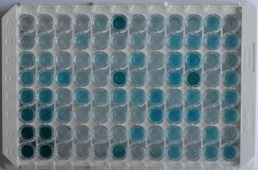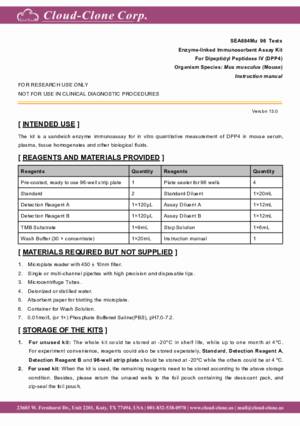Packages (Simulation)

Reagent Preparation

Image (I)
Image (II)
Certificate


ELISA Kit for Cluster Of Differentiation 26 (CD26)
CD26; ADA; DPPIV; DPP-IV; DPP4; ADABP; ADCP2; TP103; Adenosine Deaminase Complexing Protein 2; T-cell activation antigen CD26; Dipeptidyl Peptidase IV
- Product No.SEA884Mu
- Organism SpeciesMus musculus (Mouse) Same name, Different species.
- Sample Typeserum, plasma, tissue homogenates and other biological fluids
- Test MethodDouble-antibody Sandwich
- Assay Length3h
- Detection Range62.5-4,000pg/mL
- SensitivityThe minimum detectable dose of this kit is typically less than 27.7pg/mL.
- DownloadInstruction Manual
- UOM 48T96T 96T*5 96T*10 96T*100
- FOB
US$ 454
US$ 648
US$ 2916
US$ 5508
US$ 45360
For more details, please contact local distributors!
Specificity
This assay has high sensitivity and excellent specificity for detection of Cluster Of Differentiation 26 (CD26).
No significant cross-reactivity or interference between Cluster Of Differentiation 26 (CD26) and analogues was observed.
Recovery
Matrices listed below were spiked with certain level of recombinant Cluster Of Differentiation 26 (CD26) and the recovery rates were calculated by comparing the measured value to the expected amount of Cluster Of Differentiation 26 (CD26) in samples.
| Matrix | Recovery range (%) | Average(%) |
| serum(n=5) | 89-98 | 94 |
| EDTA plasma(n=5) | 91-104 | 101 |
| heparin plasma(n=5) | 88-99 | 93 |
Precision
Intra-assay Precision (Precision within an assay): 3 samples with low, middle and high level Cluster Of Differentiation 26 (CD26) were tested 20 times on one plate, respectively.
Inter-assay Precision (Precision between assays): 3 samples with low, middle and high level Cluster Of Differentiation 26 (CD26) were tested on 3 different plates, 8 replicates in each plate.
CV(%) = SD/meanX100
Intra-Assay: CV<10%
Inter-Assay: CV<12%
Linearity
The linearity of the kit was assayed by testing samples spiked with appropriate concentration of Cluster Of Differentiation 26 (CD26) and their serial dilutions. The results were demonstrated by the percentage of calculated concentration to the expected.
| Sample | 1:2 | 1:4 | 1:8 | 1:16 |
| serum(n=5) | 82-103% | 85-99% | 82-93% | 88-96% |
| EDTA plasma(n=5) | 98-105% | 84-92% | 90-104% | 91-101% |
| heparin plasma(n=5) | 80-92% | 93-104% | 92-101% | 80-99% |
Stability
The stability of kit is determined by the loss rate of activity. The loss rate of this kit is less than 5% within the expiration date under appropriate storage condition.
To minimize extra influence on the performance, operation procedures and lab conditions, especially room temperature, air humidity, incubator temperature should be strictly controlled. It is also strongly suggested that the whole assay is performed by the same operator from the beginning to the end.
Reagents and materials provided
| Reagents | Quantity | Reagents | Quantity |
| Pre-coated, ready to use 96-well strip plate | 1 | Plate sealer for 96 wells | 4 |
| Standard | 2 | Standard Diluent | 1×20mL |
| Detection Reagent A | 1×120µL | Assay Diluent A | 1×12mL |
| Detection Reagent B | 1×120µL | Assay Diluent B | 1×12mL |
| TMB Substrate | 1×9mL | Stop Solution | 1×6mL |
| Wash Buffer (30 × concentrate) | 1×20mL | Instruction manual | 1 |
Assay procedure summary
1. Prepare all reagents, samples and standards;
2. Add 100µL standard or sample to each well. Incubate 1 hours at 37°C;
3. Aspirate and add 100µL prepared Detection Reagent A. Incubate 1 hour at 37°C;
4. Aspirate and wash 3 times;
5. Add 100µL prepared Detection Reagent B. Incubate 30 minutes at 37°C;
6. Aspirate and wash 5 times;
7. Add 90µL Substrate Solution. Incubate 10-20 minutes at 37°C;
8. Add 50µL Stop Solution. Read at 450nm immediately.
GIVEAWAYS
INCREMENT SERVICES
-
 Single-component Reagents of Assay Kit
Single-component Reagents of Assay Kit
-
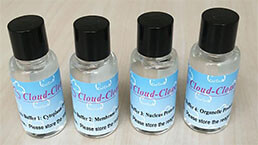 Lysis Buffer Specific for ELISA / CLIA
Lysis Buffer Specific for ELISA / CLIA
-
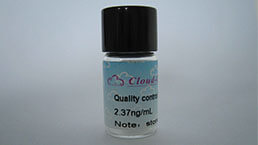 Quality Control of Kit
Quality Control of Kit
-
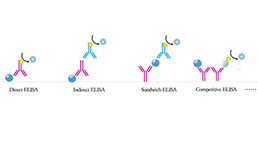 ELISA Kit Customized Service
ELISA Kit Customized Service
-
 Disease Model Customized Service
Disease Model Customized Service
-
 Serums Customized Service
Serums Customized Service
-
 TGFB1 Activation Reagent
TGFB1 Activation Reagent
-
 Real Time PCR Experimental Service
Real Time PCR Experimental Service
-
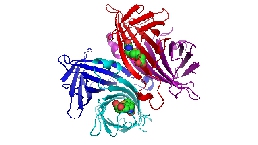 Streptavidin
Streptavidin
-
 Fast blue Protein Stain solution
Fast blue Protein Stain solution -
 Single-component Reagents of FLIA Kit
Single-component Reagents of FLIA Kit
-
 Streptavidin-Agarose Beads
Streptavidin-Agarose Beads
| Magazine | Citations |
| hormone and metabolic research | Linagliptin Blocks Renal Damage in Type 1 Diabetic Rats by Suppressing Advanced Glycation End Products-Receptor Axis Pubmed: 24710699 |
| Curr Med Chem. | MK-0626, a dipeptidyl peptidase-4 inhibitor, improves neovascularization by increasing both the number of circulating endothelial progenitor cells and endothelial nitric oxide synthetase expression. Pubmed:24059225 |
| Diabetes | Ghrelin inhibition restores glucose homeostasis in hepatocyte nuclear factor-1alpha (MODY3) deficient mice PubMed: 25979074 |
| The American Journal of the Medical Sciences | Expression and Clinical Significance of Serum Dipeptidyl Peptidase IV Chronic Obstructive Pulmonary Disease Pubmed:26992252 |
| Gene | Expression of recombinant human α-lactalbumin in milk of transgenic cloned pigs is sufficient to enhance intestinal growth and weight gain of suckling piglets Pubmed:26899869 |
| Applied In Vitro Toxicology | Hepatic Spheroids for Long-Term Toxicity Studies aivt.2016.0016 |
| BMJ Open Diab Res Care | High circulating plasma dipeptidyl peptidase- 4 levels in non-obese Asian Indians with type 2 diabetes correlate with fasting insulin and LDL-C levels, triceps skinfolds, total intra-abdominal adipose tissue volume and presence of diabetes: a case–control study 10.1136:bmjdrc-2017-000393 |
| Diabetology & Metabolic Syndrome | Dipeptidyl peptidase-4 levels are increased and partially related to body fat distribution in patients with familial partial lipodystrophy type 2 pubmed:28450900 |
| Journal of Cellular Biochemistry | The effect of CD26‐deficiency on dipeptidyl peptidase 8 and 9 expression profiles in a mouse model of Crohn's disease Pubmed:29693275 |
| Medicine (Baltimore) | Rapid detection of urinary soluble intercellular adhesion molecule-1 for determination of lupus nephritis activity Pubmed:29953010 |
| Sci Rep | The novel adamantane derivatives as potential mediators of inflammation and neural plasticity in diabetes mice with cognitive impairment Pubmed:35468904 |
| Catalog No. | Related products for research use of Mus musculus (Mouse) Organism species | Applications (RESEARCH USE ONLY!) |
| RPA884Mu02 | Recombinant Cluster Of Differentiation 26 (CD26) | Positive Control; Immunogen; SDS-PAGE; WB. |
| RPA884Mu01 | Recombinant Cluster Of Differentiation 26 (CD26) | Positive Control; Immunogen; SDS-PAGE; WB. |
| PAA884Mu02 | Polyclonal Antibody to Cluster Of Differentiation 26 (CD26) | WB; IHC; ICC; IP. |
| PAA884Mu01 | Polyclonal Antibody to Cluster Of Differentiation 26 (CD26) | WB; IHC; ICC; IP. |
| LAA884Mu71 | Biotin-Linked Polyclonal Antibody to Cluster Of Differentiation 26 (CD26) | WB; IHC; ICC. |
| SEA884Mu | ELISA Kit for Cluster Of Differentiation 26 (CD26) | Enzyme-linked immunosorbent assay for Antigen Detection. |
| LMA884Mu | Multiplex Assay Kit for Cluster Of Differentiation 26 (CD26) ,etc. by FLIA (Flow Luminescence Immunoassay) | FLIA Kit for Antigen Detection. |

